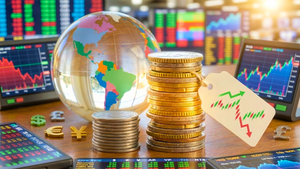The American consumer, long considered the bedrock of the US economy, is beginning to show cracks in their financial armor. As JPMorgan reported in its first-quarter earnings, the portion of credit card loans deemed unrecoverable has surged to a 13-year high, signaling a dramatic shift from the pandemic era when government stimulus programs helped consumers maintain stellar payment records. This troubling development comes at a particularly sensitive time, as households brace for potential price increases from the Trump administration's proposed tariffs on imports, creating a perfect storm of financial pressures that could reshape the economic landscape.
The reversal from pandemic-era financial stability to today's stressed conditions tells a compelling story about the changing fortunes of American households. During the height of COVID-19, consumers benefited from unprecedented government support, including stimulus checks and enhanced unemployment benefits, which actually improved credit card payment rates beyond pre-pandemic levels. Now, with those programs long ended and inflation having taken its toll, the industry-wide charge-off rate has climbed above where it stood before the coronavirus outbreak, marking a significant deterioration in consumer financial health.
The Tariff Factor and Consumer Behavior
The specter of new tariffs is already influencing consumer behavior in measurable ways. JPMorgan's chief financial officer Jeremy Barnum observed what appears to be front-loading of spending in April, particularly on items that might see price increases due to proposed tariffs. The Trump administration's plans include a 10 percent levy on general imports and a staggering 145 percent tariff on Chinese goods, prompting savvy shoppers to stock up before these policies potentially take effect. Mobile phone location data from Placer.ai reveals that consumers flocked to low-priced warehouse club stores in late March, suggesting a widespread effort to beat anticipated price hikes.
This anticipatory shopping behavior reflects deeper anxieties about the economic future. The University of Michigan's consumer sentiment survey has shown a steady decline since December, with respondents expressing growing worries about trade war developments. Perhaps most concerning, the share of survey participants expecting greater unemployment in the year ahead has reached its highest level since 2009, during the depths of the Great Recession. This pessimism creates a self-reinforcing cycle, as worried consumers may pull back on spending, potentially triggering the very economic slowdown they fear.
Major retailers are already noticing the shift in consumer patterns. Walmart's chief financial officer John David Rainey acknowledged seeing more sales volatility on a week-to-week and even day-to-day basis as consumer sentiment declines, though the company maintains its outlook for 3-4 percent growth in US net sales for the current quarter. This volatility suggests consumers are becoming more selective and strategic about their purchases, timing them around paychecks, sales events, and concerns about future price increases.
Credit Stress Indicators Mount
The Philadelphia Federal Reserve's recent report paints a concerning picture of consumer credit health, revealing that the share of credit card borrowers making only minimum payments hit a 12-year high at the end of 2024. This statistic is particularly troubling because minimum payments barely cover interest charges, meaning these consumers are treading water financially rather than making progress on their debt. The report also showed increases in accounts that were 30, 60, and 90 days past due, with revolving card balances hitting a new series high, collectively indicating what the Philadelphia Fed termed "greater consumer stress."
The financial strain extends beyond just credit cards, affecting the broader lending landscape. While this situation is particularly acute in the United States, similar patterns of consumer credit stress are emerging globally. In the United Kingdom, for instance, lenders have seen increased demand for bad credit loans as consumers with impaired credit histories seek alternative financing options. The UK market has developed specialized products for borrowers with adverse credit, offering structured repayment plans and financial education alongside lending, an approach that some US lenders are beginning to explore as they grapple with rising default rates. This international perspective highlights how consumer credit challenges transcend borders in our interconnected global economy.
Despite these warning signs, not all financial institutions are sounding alarm bells. JPMorgan's Barnum maintains that the bank's data suggests "the consumer being basically fine," noting that while lower-income consumers have relatively weaker cash buffers, they're not yet showing signs of acute distress. Wells Fargo, the fourth-largest US bank by assets, actually saw its net charge-off rate fall this quarter, though it's worth noting that Wells has a significantly smaller credit card portfolio than JPMorgan. Wells' chief financial officer Mike Santomassimo emphasized that customers continue to show resilience with stable activity in both credit and debit card spending.
Jamie Dimon, JPMorgan's chief executive, offered a measured perspective on the situation, acknowledging "a wide range of potential outcomes" in this period of uncertainty. He sided with his bank's economists in putting the odds of a recession at 50-50, neither dismissing concerns nor embracing panic. Dimon emphasized that credit quality almost always correlates directly with employment levels, suggesting that the current unemployment rate of about 4.2 percent remains the crucial metric to watch. As he put it, credit quality will change when unemployment changes, making job market stability the key factor in determining whether current stress levels escalate into a broader crisis.
The diverging signals from various economic indicators create a complex picture that defies simple interpretation. While credit card defaults and minimum payment statistics suggest growing stress, continued consumer spending and relatively stable employment provide counterbalancing positive signs. This mixed data reflects an economy in transition, where pandemic-era supports have ended, inflation has eroded purchasing power, and new policy uncertainties loom on the horizon. The coming months will likely prove decisive in determining whether current stress levels represent a temporary adjustment or the beginning of a more serious economic downturn.
As American consumers navigate these choppy financial waters, their collective decisions about spending, saving, and borrowing will shape not just their own financial futures but the trajectory of the entire US economy. With consumer spending accounting for roughly 70 percent of economic activity, even modest pullbacks in purchasing could have outsized effects on growth. The challenge for policymakers, lenders, and retailers alike will be supporting consumer financial health while adapting to a new reality where the extraordinary supports of the pandemic era are no longer available, and where global trade tensions add another layer of uncertainty to household budgeting decisions.
Media Contact
Company Name: Evlo
Contact Person: Jono Gillespie
Email: Send Email
Address:Suite 3, 1st Floor, Aquasulis House, 10-14 Bath Road
City: Slough, SL1 3SQ
Country: United Kingdom
Website: evlo.co.uk






